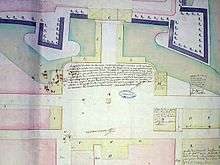Place Stanislas
| Place Stanislas, Place de la Carrière and Place d'Alliance in Nancy | |
|---|---|
| Name as inscribed on the World Heritage List | |
 | |
| Location | France |
| Type | Cultural |
| Criteria | i, iv |
| Reference | 229 |
| UNESCO region | Europe, Canada, USA |
| Coordinates | 48°41′37″N 6°10′59″E / 48.69361°N 6.18306°ECoordinates: 48°41′37″N 6°10′59″E / 48.69361°N 6.18306°E |
| Inscription history | |
| Inscription | 1983 (7th Session) |
 Location within France | |
The Place Stanislas, known colloquially as the place Stan', is a large pedestrianised square in the French city of Nancy, in the Lorraine region. Since 1983, the architectural ensemble comprising the Place Stanislas, the extension of its axis, the Place de la Carrière, and the Place d'Alliance, has been on the list of UNESCO World Heritage Sites.[1]
History
Background
After the War of the Polish Succession in 1737, the Duchy of Upper Lorraine, of which Nancy was the capital, was given to Stanisław I Leszczyński, former Ruler of Polish-Lithuanian Commonwealth and father-in-law to King Louis XV of France. An earlier ruler, Leopold, Duke of Lorraine, had undertaken a lot of reconstruction in Lorraine, which had been ravaged by a series of wars. He had surrounded himself by artists and architects, including Germain Boffrand, who trained Emmanuel Héré. Hence, Stanisław found a pool of talent and experience to draw from on his arrival.[2]
Design and construction

The square was a major project in urban planning, dreamt up by Stanisław I, as a way to link the medieval old town of Nancy and the new town built under Charles III in the 17th century. The square would also be a place royale to honour his son-in-law, Louis XV. The design linked two handsome buildings that already existed: the Hôtel de Ville (now centred on its grand square) and the Hôtel du Gouvernement. The seat of city government and the seat of Ducal government[3] faced each other as complements through a series of rational, symmetrical but varied urban spaces, unequalled in Europe at the time.
The square and the surrounding buildings, unified by their colossal orders, were designed by the royal architect Emmanuel Héré de Corny (1705–1763).[1] Construction began in March 1752,[1] and ended in November 1755. Barthélémy Guibal and Paul-Louis Cyfflé created a bronze statue of Louis XV, which stood in the middle of the square until it was removed during the Revolution, and was replaced with a simple winged figure. The square was renamed 'Place du Peuple', and later 'Place Napoléon'.
In 1831, a bronze statue of Stanisław (Stanislas in French) was placed in the middle of the square, since then known as the 'Place Stanislas'.
The square has always been used for public assemblies and festivities, but it has undergone several makeovers in its history, even serving as a car parking area between 1958 and 1983. In 2004 and 2005, the square underwent a massive restoration, inspired by the original 18th-century plans. The ten-month project cost approximately 9 million euros.[4] The inauguration of the new Place Stanislas, in May 2005, coincided with the square's 250th anniversary.
Description

The Place Stanislas is 125 metre long and 106 metre wide. It is paved with light ochre stones, with two lines of darker stones forming a diagonal cross motif. The square is surrounded by an architecturally harmonious ensemble of buildings, most notably these:
- The City Hall (Hôtel de Ville) of Nancy, which occupies the entire south side of the square, with the prefectural office of Meurthe-et-Moselle at the south-east corner;
- To the east, the Opera house (formerly the Bishop's Palace) and the Grand Hôtel (originally the Hôtel de la Reine, actually occupied by the Intendant Alliot);
- To the west, the Fine Arts Museum (originally the Collège de médecine) and the Pavillon Jacquet (originally a commercial/residential building, now mostly offices);[5]
- On the north side, the buildings were kept lower for defensive purposes (to permit crossfire between the Vaudemont and the Haussonville bastions).
An arc de triomphe, by Emmanuel Héré, stands in the centre of the fourth side, leading to the adjoining Place de la Carrière, where the main axis is developed as a double avenue of trees, with symmetrical buildings facing each other down its length.
The far end is defined by the hemi-cycles of colonnades that enclose the sides and are carried across the pre-existing façade of the Palais du Gouvernement.
The four corners and the west and east sides of the square feature gilded wrought iron gates and lanterns, created by Jean Lamour (1698–1771); who was also responsible for the wrought iron balustrade on the main staircase in the Hôtel de Ville, and the balcony across the centre of its main façade. The north-west and north-east corners also feature ornate fountains designed by Barthélémy Guibal (1699–1757).


Central statue
The statue in the centre of the Place Stanislas, created by Georges Jacquot, represents Stanislas standing, dressed in flowing robes, holding a sword in his left hand and pointing towards the north with his right hand. The inscriptions on the high marble pedestal read:
| • South face: | Stanislas Leszczynski, Roi de Pologne, Duc de Lorraine et de Bar, 1737-1766 |
| (Stanislas Leszczynski, King of Poland, Duke of Lorraine and Bar, 1737–1766) | |
| • North face: | À Stanislas le Bienfaisant, la Lorraine Reconnaissante, 1831, Meurthe-Meuse-Vosges |
| (To Stanislas the Benefactor, Lorraine [is] grateful, 1831, Meurthe-Meuse-Vosges) |
Hôtel de Ville

The Hôtel de Ville (City Hall), also known as Palais de Stanislas (Stanislas's Palace), is the largest building in the square at 98 metres long, and occupies the whole south side of the square. Built in 1752-1755, it has served as the city hall since its construction. It was designated as a monument historique on 12 July 1886.[6][7]
See also
Notes
- 1 2 3 "Place Stanislas, Place de la Carrière and Place d'Alliance in Nancy". United Nations: UNESCO World Heritage Centre. UNESCO.org. Retrieved 11 July 2016.
- ↑ Pupil, François. "Pose de la première pierre de la Place Royale de Nancy". Célébrations nationales 2002 (in French). Retrieved 5 April 2011.
- ↑ The governor, in fact, was handpicked by Louis XV's ministers.
- ↑ The final budget for the entire two-year operation 'Nancy 2005, le temps des Lumières', including the restoration of the Place Stanislas and associated festivities, was 9.45 million euros (about half provided by city and local funds, the other half by regional, national, and private funds).
- ↑ Demolière, Hippolyte-Jules (1855). De Paris à Strasbourg (in French). L. Hachette et cie. p. 71.
Le pavillon Jacquet, occupé par des marchands et des particuliers.
("The Jacquet House: occupied by merchants and private citizens.") - ↑ Archived January 2, 2011, at the Wayback Machine.
- ↑ Base Mérimée: Hôtel de Ville
References
- Simon, Pierre. 1994. Nancy : la ville de Stanislas. Metz: Editions Serpenoise. ISBN 2-87692-209-6
External links
| Wikimedia Commons has media related to Place Stanislas. |
- Video of Place Stanislas — UNESCO World Heritage Centre
- Place Stanislas, the Tourist Information Office in Nancy
